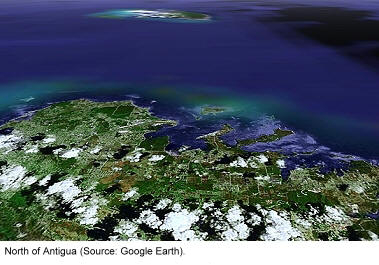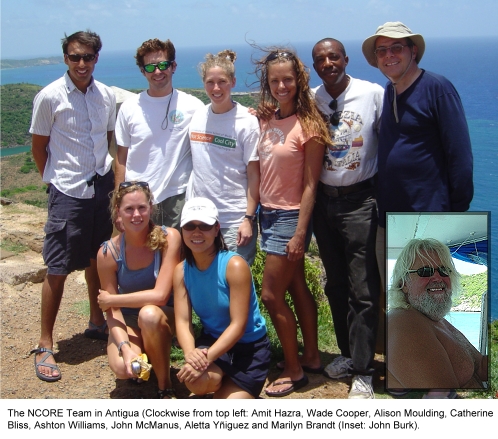|
 A
coral reef survey conducted in the North Sound region of Antigua between August 1st and 5th, 2005. This survey was supported by the
Stanford Development Corporation and was conducted using the benthic and
fish surveying methods of the Atlantic and Gulf Rapid Reef Assessment (AGRRA)
program. A
coral reef survey conducted in the North Sound region of Antigua between August 1st and 5th, 2005. This survey was supported by the
Stanford Development Corporation and was conducted using the benthic and
fish surveying methods of the Atlantic and Gulf Rapid Reef Assessment (AGRRA)
program.
Results of the survey in the North Sound show a relatively healthy benthic
community but an unhealthy and disturbed fish community. In comparison to other
Caribbean sites in the AGRRA database, indicators of reef health of the benthic
community of the North Sound rank relatively high. Live coral cover was high,
the abundance of macroalgae (competitors with coral) was low, and the abundance
of a major herbivore, the long-spined sea urchin (Diadema antillarum) was
the second highest recorded in the AGRRA database. When compared to deeper sites
located farther from shore on the west and southwest bank of Antigua, the
habitat complexity of the North Sound would predict a more diverse and abundant
fish community however, the opposite result was found. Overall, total fish
abundance ranks comparatively high as well, but this is due to the relatively
high abundance of very small herbivores on these reefs. Carnivores, specifically
piscivores, and large herbivores were almost entirely absent from surveys,
indicating a severely depleted and disturbed fish community.

Despite the presence of large
reef areas of the North Sound dominated by coral rubble and standing dead
colonies, indicating significant mortality of coral in the past, all indicators
of reef health from our survey suggest a healthy and diverse re-colonizing
benthos with the potential for future recovery and growth.
However, the fish community is severely under-populated relative to the
potential provided by the amount of available habitat in the North Sound area.
These low abundances could be due to multiple factors, including increased adult
mortality due to fishing pressures, as well as potentially a lack of larval fish
supply from nearby reef areas. To address these issues, more information is
needed on the oceanographic conditions and demographics of fishing effort in
this region.
In addition, documentation of the distribution and composition of
both the benthic and fish communities within the entire Antigua-Barbuda shelf
system is needed to properly assess the condition of these populations, and
assess the extent and potential for recovery in the Sound and elsewhere (see
separate report on the
sedimentological description of the area). There
were reef areas where seaweed levels were not as excessive as on reefs in some
other countries, possibly indicating low nutrient levels. However, upcoming
changes to the watersheds make it vital that a thorough understanding of
nutrient processes affecting the reefs be attained, particularly given the
increased sensitivity to nutrient loading often associated with a disturbed fish
community.
Report Links:
|
|
